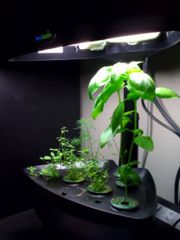Food/Controlled Environment Agriculture
Food production is seen as resource-intensive, requiring a lot of water, land, labour, and environmental impact. But what if we had a method of growing plants that needed 98% less water, 99% less land and 100% less fertilizer, pesticide and labour?
Aeroponics is the art of growing plants with their roots in air rather than in soil. The roots are intermittently spraying with nutrient-enriched water. This allows for precise control of the amount of nutrients that the plants receive.
The figures on Wikipedia  show that hydroponics (growing plants with their roots in a pool of nutrient-enriched water) yields are 50% to over 1700% higher than yields from growing in soil. Aeroponics yields are significantly higher even than those from hydroponics [1] [2].
show that hydroponics (growing plants with their roots in a pool of nutrient-enriched water) yields are 50% to over 1700% higher than yields from growing in soil. Aeroponics yields are significantly higher even than those from hydroponics [1] [2].
Controlled-environment growing lends itself readily to automation. Best of all, by optimizing the nutrient flow, we can supply plants with the nutrients they need to produce the flavonoids that give them their flavour. With controlled growing, it is possible to achieve a more intense flavour than growing in soil.
A controlled environment allows food to be grown year-round, independent of seasons. This is known as constant-yield growing. While only one harvest a year can be grown conventionally, constant-yield growth gives 4-30 harvests a year, depending on the plant.
A controlled environment greatly reduces the threat of pests and plant-diseases, eliminating the need for pesticides.
Hydroponics uses 5-10% the water used for growing in soil [3]. And aeroponics uses 65% less water again, and only a quarter the nutrients [4]. This will make huge difference if we want to preserve our water resources, as 69% of all our water use is for agriculture [5].
Both of the necessary inputs for aeroponics - water and minerals - are in enormous abundance on Earth.
It has already been demonstrated that a hydroponics garden can grow 2kg of vegetables a day (more than enough to nourish a person) in 20 square meters [6] and aeroponics could reduce this space even further. It is realistic to stack five layers of crops one on top of another in a 2m high system, reducing the area needed from 20m2 to 4m2.Omega Garden uses an innovative cylindrical design in which plants are constantly tilted so they have to adjust to gravity. This results in stronger, more compact growth. It is claimed that this method can result in a fivefold increase over other plants grown in the same conditions but without rotation.
LEDs can be used to provide light for plants. LEDs could be useful in situations where sunlight is unavailable - such as in winter in regions far from the Equator, in underground or underwater dwellings, in cities where a demand for space means food must be grown on stacked shelves indoors, and in space habitats. Currently the main obstacle to large-scale controlled environment agriculture projects such as The Vertical Farm Project is the cost of energy needed to provide the light. As LEDs become cheaper and more energy-efficient (as with recent developments in OLED and PHOLED technology) this sort of production of high-quality food is becomes more and more feasible.
Using fibre-optic cables to pipe sunlight down from the rooftop to the plants would significantly reduce the amount of energy needed.
Using aeroponics and LED grow lights, the conditions of plant-growth can be precisely monitored, controlled and optimized. Dickson Despommier, an advocate of vertical, controlled-environment farming, has painted a picture of what this farming might be like -"Each floor will have its own watering and nutrient monitoring systems. There will be sensors for every single plant that tracks how much and what kinds of nutrients the plant has absorbed. You'll even have systems to monitor plant diseases by employing DNA chip technologies that detect the presence of plant pathogens by simply sampling the air and using snippets from various viral and bacterial infections. It's very easy to do.
Moreover, a gas chromatograph will tell us when to pick the plant by analyzing which flavenoids the produce contains. These flavenoids are what gives the food the flavors you're so fond of, particularly for more aromatic produce like tomatoes and peppers. These are all right-off-the-shelf technologies. The ability to construct a vertical farm exists now. We don't have to make anything new."
Cities have always depended on transporting food from the countryside. But automation and the tiny amount of land needed for aeroponics changes this. Controlled-environment growing plus in-vitro meat could lead to the novel phenomenon of cities that can produce all their own food. A city-dweller can now grow all their own food in a small apartment, so food-production does not necessarily depend on farming. The food we eat will be local and fresh. For the same reasons, aeroponics and in-vitro meat are important pieces of the space colony puzzle.
Algorithms could be developed and shared online to model nutrient flow, timing, duration, intensity and color of light, and strains of plants used affects food yields and flavour. Programming these algorithms into computers that control the LED lights and the nutrient flow in the aeroponic system would yield a truly automated food-production system that anyone could use to grow their own food indoors. All this technology exists currently, and is being constantly improved and refined.
Aeroponic plant production is the most advanced method of growing food available. Not only does it achieve incredibly high yields in short times, it lends itself easily to automation, while minimizing water, energy and land use, maximizing nutritional values and producing awesome food.

